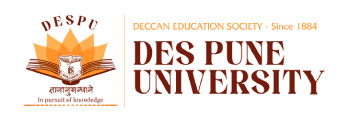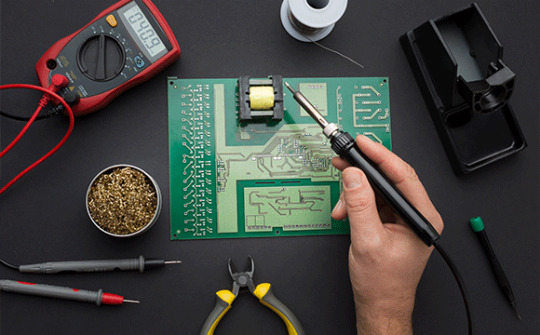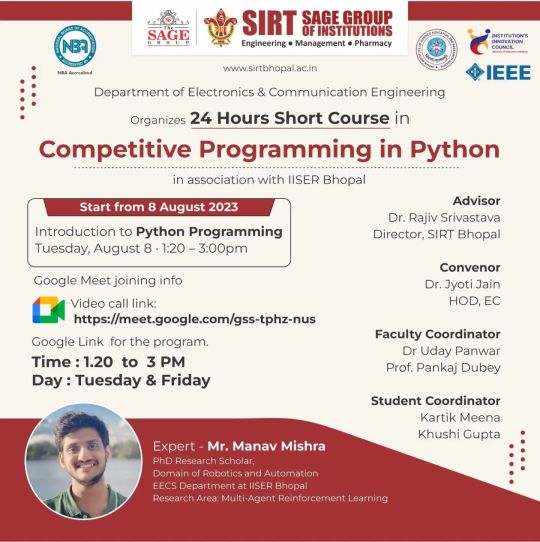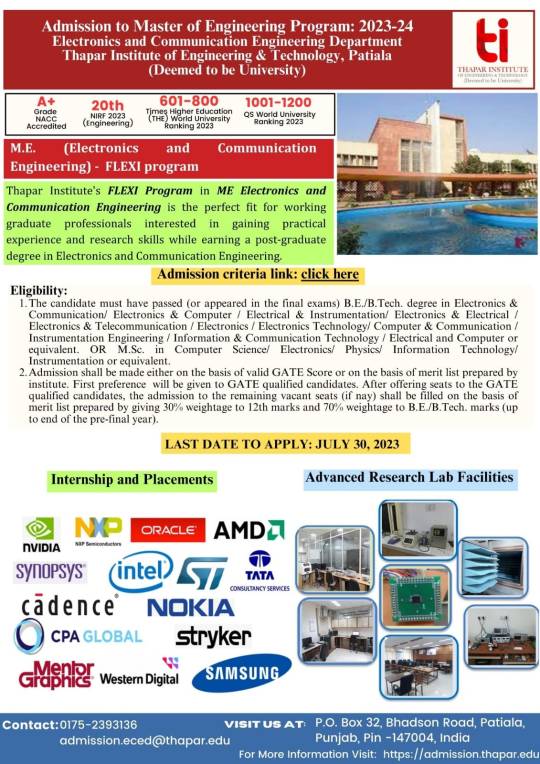#electronics and communication courses
Explore tagged Tumblr posts
Text

Why is the Electronic and Communication Engineering Course Right for Your Career?
Discover why Electronics and Communication courses are ideal for your career growth. Explore the vast scope of Electronics and Telecommunication Engineering today!
#electronics and communication engineering#electronics and communication engineering colleges in kolkata#electronics and communication courses#electronics and telecommunication engineering#electrical communication engineering#electronics & telecommunication engineering#be electronics and telecommunication#courses after diploma in electrical and electronics engineering#electronics course near me#electronics telecommunication engineering#electronics training courses#electronics training institute#electronics and telecommunication engineering scope
0 notes
Photo

UEE40720 – Certificate IV in Electronics and Communications qualification at APEIRO Institute provides competencies in audio/video, data systems, computer and network hardware, medical applications, and communication aspects of electronic such as transmitters, communications channel, receivers, attenuation, noise reduction.
0 notes
Text
Was thinking of the possibility of THC existing in DT (bunch of other people and properties do so why wouldn't it?) and I do realize to make a centipede out of object heads is objectively more gruesome than the actual thing. Probably higher survival change though? I couldn't being to speculate on typewriter anatomy tho and the possibility of complete face change is off the table imo since it's a single surgeon doing this in a single day it wouldn't work. Much to think about...
#luly talks#with that said waterboarding is definitely more brutal in a society revolving around electronics compared to Our One#im talking of 3 there of course#boiling too that'd melt the plastic YEOOOOWWWCHHH#should i even put this on the main tags? i feel it's way too indulgent#i don't think there's any fucking overlap between these communities#changed my mind!!!!!!!! im tagging this. -_-#idk if itll show up in the tags anymore but at least i'll do so in my blog Heart#dialtown#the human centipede
4 notes
·
View notes
Text
Woxsen University is recognized as one of the top B.Tech colleges in India, offering cutting-edge programs in engineering and technology. Its B.Tech curriculum is designed to equip students with technical expertise and problem-solving skills through a blend of theoretical knowledge and practical application. Woxsen provides specializations in Artificial Intelligence, Data Science, and other emerging fields, ensuring that graduates are industry-ready. The university’s state-of-the-art labs, experienced faculty, and industry partnerships create a learning environment that fosters innovation and career success.

#b tech course fees#top B.Tech colleges in India#B.Tech in computer science engineering#B.Tech CSE data science#B.Tech in artificial intelligence and machine learning#B.Tech in electronics and communication engineering#private colleges for btech
0 notes
Text
Best B.Tech ECE Advanced Communication College Bareilly
Looking for the best B.Tech college in Electronics and Communication Engineering in Bareilly? Future University offers advanced courses in ECE with cutting-edge labs, expert faculty, and excellent placement opportunities. Gain the skills you need for a bright career in communication technology and innovation!
#best b.tech ece college bareilly#electronics & communication engineering course bareilly#top advanced communication technology college bareilly
1 note
·
View note
Text
Smart handling of neutrons is crucial to fusion power success
New Post has been published on https://thedigitalinsider.com/smart-handling-of-neutrons-is-crucial-to-fusion-power-success/
Smart handling of neutrons is crucial to fusion power success


In fall 2009, when Ethan Peterson ’13 arrived at MIT as an undergraduate, he already had some ideas about possible career options. He’d always liked building things, even as a child, so he imagined his future work would involve engineering of some sort. He also liked physics. And he’d recently become intent on reducing our dependence on fossil fuels and simultaneously curbing greenhouse gas emissions, which made him consider studying solar and wind energy, among other renewable sources.
Things crystallized for him in the spring semester of 2010, when he took an introductory course on nuclear fusion, taught by Anne White, during which he discovered that when a deuterium nucleus and a tritium nucleus combine to produce a helium nucleus, an energetic (14 mega electron volt) neutron — traveling at one-sixth the speed of light — is released. Moreover, 1020 (100 billion billion) of these neutrons would be produced every second that a 500-megawatt fusion power plant operates. “It was eye-opening for me to learn just how energy-dense the fusion process is,” says Peterson, who became the Class of 1956 Career Development Professor of nuclear science and engineering in July 2024. “I was struck by the richness and interdisciplinary nature of the fusion field. This was an engineering discipline where I could apply physics to solve a real-world problem in a way that was both interesting and beautiful.”
He soon became a physics and nuclear engineering double major, and by the time he graduated from MIT in 2013, the U.S. Department of Energy (DoE) had already decided to cut funding for MIT’s Alcator C-Mod fusion project. In view of that facility’s impending closure, Peterson opted to pursue graduate studies at the University of Wisconsin. There, he acquired a basic science background in plasma physics, which is central not only to nuclear fusion but also to astrophysical phenomena such as the solar wind.
When Peterson received his PhD from Wisconsin in 2019, nuclear fusion had rebounded at MIT with the launch, a year earlier, of the SPARC project — a collaborative effort being carried out with the newly founded MIT spinout Commonwealth Fusion Systems. He returned to his alma mater as a postdoc and then a research scientist in the Plasma Science and Fusion Center, taking his time, at first, to figure out how to best make his mark in the field.
Minding your neutrons
Around that time, Peterson was participating in a community planning process, sponsored by the DoE, that focused on critical gaps that needed to be closed for a successful fusion program. In the course of these discussions, he came to realize that inadequate attention had been paid to the handling of neutrons, which carry 80 percent of the energy coming out of a fusion reaction — energy that needs to be harnessed for electrical generation. However, these neutrons are so energetic that they can penetrate through many tens of centimeters of material, potentially undermining the structural integrity of components and damaging vital equipment such as superconducting magnets. Shielding is also essential for protecting humans from harmful radiation.
One goal, Peterson says, is to minimize the number of neutrons that escape and, in so doing, to reduce the amount of lost energy. A complementary objective, he adds, “is to get neutrons to deposit heat where you want them to and to stop them from depositing heat where you don’t want them to.” These considerations, in turn, can have a profound influence on fusion reactor design. This branch of nuclear engineering, called neutronics — which analyzes where neutrons are created and where they end up going — has become Peterson’s specialty.
It was never a high-profile area of research in the fusion community — as plasma physics, for example, has always garnered more of the spotlight and more of the funding. That’s exactly why Peterson has stepped up. “The impacts of neutrons on fusion reactor design haven’t been a high priority for a long time,” he says. “I felt that some initiative needed to be taken,” and that prompted him to make the switch from plasma physics to neutronics. It has been his principal focus ever since — as a postdoc, a research scientist, and now as a faculty member.
A code to design by
The best way to get a neutron to transfer its energy is to make it collide with a light atom. Lithium, with an atomic number of three, or lithium-containing materials are normally good choices — and necessary for producing tritium fuel. The placement of lithium “blankets,” which are intended to absorb energy from neutrons and produce tritium, “is a critical part of the design of fusion reactors,” Peterson says. High-density materials, such as lead and tungsten, can be used, conversely, to block the passage of neutrons and other types of radiation. “You might want to layer these high- and low-density materials in a complicated way that isn’t immediately intuitive” he adds. Determining which materials to put where — and of what thickness and mass — amounts to a tricky optimization problem, which will affect the size, cost, and efficiency of a fusion power plant.
To that end, Peterson has developed modelling tools that can make analyses of these sorts easier and faster, thereby facilitating the design process. “This has traditionally been the step that takes the longest time and causes the biggest holdups,” he says. The models and algorithms that he and his colleagues are devising are general enough, moreover, to be compatible with a diverse range of fusion power plant concepts, including those that use magnets or lasers to confine the plasma.
Now that he’s become a professor, Peterson is in a position to introduce more people to nuclear engineering, and to neutronics in particular. “I love teaching and mentoring students, sharing the things I’m excited about,” he says. “I was inspired by all the professors I had in physics and nuclear engineering at MIT, and I hope to give back to the community in the same way.”
He also believes that if you are going to work on fusion, there is no better place to be than MIT, “where the facilities are second-to-none. People here are extremely innovative and passionate. And the sheer number of people who excel in their fields is staggering.” Great ideas can sometimes be sparked by off-the-cuff conversations in the hallway — something that happens more frequently than you expect, Peterson remarks. “All of these things taken together makes MIT a very special place.”
#2024#Algorithms#ALMA#Alternative energy#Alumni/ae#analyses#atom#atomic#attention#background#billion#Building#career#career development#code#collaborative#Community#course#Department of Energy (DoE)#Design#Design Process#development#double#efficiency#electron#Emissions#energy#engineering#equipment#excel
0 notes
Text
Notable activities of the Electronics and Communication Engineering department
#Notable activities of the Electronics and Communication Engineering department#ece department in krct#results#admission#opportunities of ece department#best engineering course ece#ai college#councilling
0 notes
Text
seriously, though. i work in higher education, and part of my job is students sending me transcripts. you'd think the ones who have the least idea how to actually do that would be the older ones, and while sure, they definitely struggle with it, i see it most with the younger students. the teens to early 20s crowd.
very, astonishingly often, they don't know how to work with .pdf documents. i get garbage phone screenshots, sometimes inserted into an excel or word file for who knows what reason, but most often it's just a raw .jpg or other image file.
they definitely either don't know how to use a scanner, don't have access to one, or don't even know where they might go for that (staples and other office supply stores sometimes still have these services, but public libraries always have your back, kids.) so when they have a paper transcript and need to send me a copy electronically, it's just terrible photos at bad angles full of thumbs and text-obscuring shadows.
mind bogglingly frequently, i get cell phone photos of computer screens. they don't know how to take a screenshot on a computer. they don't know the function of the Print Screen button on the keyboard. they don't know how to right click a web page, hit "print", and choose "save as PDF" to produce a full and unbroken capture of the entirety of a webpage.
sometimes they'll just copy the text of a transcript and paste it right into the message of an email. that's if they figure out the difference between the body text portion of the email and the subject line, because quite frankly they often don't.
these are people who in most cases have done at least some college work already, but they have absolutely no clue how to utilize the attachment function in an email, and for some reason they don't consider they could google very quickly for instructions or even videos.
i am not taking a shit on gen z/gen alpha here, i'm really not.
what i am is aghast that they've been so massively failed on so many levels. the education system assumed they were "native" to technology and needed to be taught nothing. their parents assumed the same, or assumed the schools would teach them, or don't know how themselves and are too intimidated to figure it out and teach their kids these skills at home.
they spend hours a day on instagram and tiktok and youtube and etc, so they surely know (this is ridiculous to assume!!!) how to draft a formal email and format the text and what part goes where and what all those damn little symbols means, right? SURELY they're already familiar with every file type under the sun and know how to make use of whatever's salient in a pinch, right???
THEY MUST CERTAINLY know, innately, as one knows how to inhale, how to type in business formatting and formal communication style, how to present themselves in a way that gets them taken seriously by formal institutions, how to appear and be competent in basic/standard digital skills. SURELY. Of course. RIGHT!!!!
it's MADDENING, it's insane, and it's frustrating from the receiving end, but even more frustrating knowing they're stumbling blind out there in the digital spaces of grown-up matters, being dismissed, being considered less intelligent, being talked down to, because every adult and system responsible for them just
ASSUMED they should "just know" or "just figure out" these important things no one ever bothered to teach them, or half the time even introduce the concepts of before asking them to do it, on the spot, with high educational or professional stakes.
kids shouldn't have to supplement their own education like this and get sneered and scoffed at if they don't.
24K notes
·
View notes
Text
Deccan Education Society: Excellence in Pune's B Tech & PG Diplomas

Pune, often dubbed as the "Oxford of the East," has been a pivotal hub for higher education in India. Amidst its educational glory, the Deccan Education Society stands out as a beacon of academic excellence and tradition. Founded with the aim of creating a literate, enlightened society, the Deccan Education Society has etched its name in the annals of educational history. Today, it opens the doors to a plethora of opportunities for aspiring engineers and professionals through its distinguished B.Tech and PG Diploma courses, particularly in the sought-after fields of Computer Science and Electronics & Communication Engineering.
A Legacy of Enlightenment
The Deccan Education Society Pune University is an emblem of educational heritage, reflecting the vision of its founders to impart quality education to all segments of society. This prestigious institution is not just a name but a legacy that has been nurturing minds and fostering innovation for decades. Its commitment to excellence has made it a preferred destination for students aiming to excel in the realms of technology and engineering.
B.Tech Computer Science Colleges in Pune
For tech enthusiasts dreaming of diving into the world of programming, algorithms, and systems, the B Tech in Computer Science colleges in Pune affiliated with the Deccan Education Society offers an unmatched curriculum. These institutions are renowned for their cutting-edge laboratories, experienced faculty, and a dynamic learning environment that encourages practical learning and innovation. Students are prepared to face the global challenges of the IT industry, making these colleges a prime choice for aspiring software engineers and tech professionals.
B.Tech Electronics and Communication Engineering
The field of Electronics and Communication Engineering (ECE) is at the heart of the digital revolution. Btech electronics and communication engineering colleges under the Deccan Education Society provide a comprehensive B.Tech program in ECE designed to meet the ever-evolving demands of the telecommunications, electronics, and information technology sectors. Through a blend of theoretical knowledge and hands-on experience, students gain expertise in designing, analyzing, and implementing electronic systems, opening a pathway to a future filled with promising opportunities in both the public and private sectors.
PG Diploma Courses in Pune
Beyond undergraduate programs, the Deccan Education Society also offers an array of PG Diploma courses in Pune, catering to the need for specialized knowledge and skills in various professional fields. These courses are tailored for graduates seeking to enhance their qualifications, improve job prospects, or shift career paths. With a focus on industry-relevant curricula, these PG Diploma programs ensure that students are well-equipped to tackle the challenges of the professional world.
DES Pune University: A Pinnacle of Academic Excellence
As we delve deeper into the academic opportunities in Pune, it's imperative to highlight the role of DES Pune University in shaping the educational landscape. The Deccan Education Society's affiliation with Pune University marks a collaboration that leverages the best of tradition and modernity, fostering an environment of excellence and innovation. DES Pune University is not just an institution; it is a community of scholars, educators, and students committed to the pursuit of knowledge and the betterment of society.
This partnership enriches the academic offerings, with DES leveraging the resources, research facilities, and academic prowess of Pune University. The synergy between the two institutions amplifies their impact, creating an ecosystem that nurtures critical thinking, creativity, and a passion for lifelong learning. Students of DES have the unique advantage of accessing Pune University's vast library, engaging in interdisciplinary research, and participating in seminars, workshops, and conferences that broaden their academic horizons.
Conclusion
The Deccan Education Society stands as a testament to the power of education in transforming lives and communities. Through its top-tier B.Tech and PG Diploma courses in Pune, the society continues to mold future leaders, innovators, and professionals. Whether it's breaking new ground in Computer Science or pioneering advancements in Electronics and Communication Engineering, the institutions under this venerable society are paving the way for a brighter, more technologically advanced future. Aspiring students and professionals looking to make their mark in the engineering and technology fields will find the Deccan Education Society an exemplary gateway to achieving their dreams.
#b tech in computer science colleges in Pune#B Tech computer science colleges in Pune#Deccan Education Society Pune University#Btech electronics and communication engineering#PG Diploma courses in Pune#DES Pune university
0 notes
Text
Mtech In Electronics And Communication Engineering In Kolkata
The course has a detailed M tech electronics and communication engineering syllabus that emphasizes a balanced approach between theoretical concepts and practical applications. Students will have access to state-of-the-art laboratories equipped with cutting-edge equipment and software.

#M tech electronics and communication engineering syllabus#M tech in electronics and communication engineering course
0 notes
Text
The Subjects Of Electronics And Communication Engineering
It is a fundamental subject in Electronics and Communication Engineering colleges, as it allows them to design and optimize communication systems.

#electronics and communication engineering#electronics and communication engineering colleges in kolkata#electronics and communication courses#electronics and telecommunication engineering#electronics & telecommunication engineering
0 notes
Text
youtube
#gate ece#gate ece 2024#gate ece preparation 2024#gate ece video lectures#gate ece cse eee#gate ece 2023 solutions#gate ec cs ee course#gate ece lecture#gate coaching for electronics and communication engineering#gate coaching online#gate classes for electronics computer electrical engineering#gate aptitude#gate aptitude lectures#gate aptitude question and answer#gate aptitude 2024#gate aptitude ece cse eee#gate aptitude previous year solution#gate core ec cs#Youtube
0 notes
Text
youtube
VHDL Basics - Language for Hardware Design : Know why you need to learn VHDL?
What is VHDL? VHDL, short for Very High-Speed Integrated Circuit Hardware Description Language, is a powerful and widely used language for designing digital circuits and systems. If you're interested in digital electronics or pursuing a career in hardware design, learning VHDL is essential. Why Learn VHDL? Understanding VHDL gives you the ability to design and simulate complex digital systems, ranging from simple logic gates to advanced processors. VHDL allows you to describe the behavior and structure of these circuits accurately, enabling efficient development and debugging. By learning VHDL, you gain the skills to create efficient and reliable hardware designs. How to Learn VHDL? Learning VHDL doesn't have to be intimidating! In this tutorial video, we will guide you through the basics of VHDL, explaining the syntax, data types, and essential concepts. We'll also provide practical examples and hands-on exercises to reinforce your understanding. Whether you're a beginner or have some experience with digital design, this video will help you grasp VHDL quickly. Join Our VHDL Community Connect with fellow VHDL enthusiasts and learners in our vibrant community. Share ideas, ask questions, and collaborate with others passionate about hardware design. Our community is a supportive and engaging space to expand your knowledge and stay updated with the latest VHDL developments. Subscribe to Learn and Grow Community for Regular updates. Subscribe to our community for more informative videos and guidance. Stay tuned for tutorials, tips, and tricks to enhance your skills. Hit the notification bell to never miss an update.
Subscribe to "Learn And Grow Community"
YouTube : https://www.youtube.com/@LearnAndGrowCommunity
LinkedIn Group : https://www.linkedin.com/groups/7478922/
Blog : https://LearnAndGrowCommunity.blogspot.com/
Facebook : https://www.facebook.com/JoinLearnAndGrowCommunity/
Twitter Handle : https://twitter.com/LNG_Community
DailyMotion : https://www.dailymotion.com/LearnAndGrowCommunity
Instagram Handle : https://www.instagram.com/LearnAndGrowCommunity/
Follow #LearnAndGrowCommunity
#VHDL#VHDL tutorial#hardware design#digital electronics#VHDL language#VHDL basics#learn VHDL#VHDL syntax#VHDL community#VHDL beginners#digital design#hardware simulation#VHDL examples#VHDL exercises#VHDL processor#VHDL development#Engineering projects#verilog hdl#Free courses#Learn VHDL#Learn Verilog#tutorials#classes#training#career#vlsi industry#job#Youtube
1 note
·
View note
Text
Common Mobile and Laptop Issues You Can Fix with Training from Magnus Institute of Technology
In today’s fast-paced digital world, mobile phones and laptops are integral to our personal and professional lives. But what happens when these essential devices break down? From cracked screens to software issues, the demand for skilled mobile and laptop repair technicians is skyrocketing. At Magnus Institute of Technology, our Mobile and Laptop Repairing Course prepares students to tackle a wide array of device problems efficiently and professionally.
In this blog, we’ll explore some of the most common mobile and laptop issues that you will learn to repair through our mobile phone technician course and laptop repairing course.
1. Cracked or Broken Screens
One of the most frequent issues mobile and laptop users face is a cracked or shattered screen. Whether it's a smartphone, iPhone, or laptop, screen damage can render a device nearly unusable.
What You’ll Learn:
How to carefully remove the damaged screen.
How to replace the screen with a new one while ensuring no internal components are damaged.
Proper calibration and testing after replacement.
As part of our mobile repairing course at Magnus Institute of Technology, students will learn step-by-step techniques for screen replacements on different devices.
2. Battery Replacement
Another common issue in both smartphones and laptops is battery wear and tear. Over time, batteries lose their ability to hold a charge, causing devices to run out of power quickly.
What You’ll Learn:
How to diagnose battery issues.
How to safely remove the old battery and replace it with a new one.
Techniques for calibrating and testing the battery to ensure it works properly after replacement.
Our laptop repair training will provide you with hands-on experience to handle battery replacements for both mobile phones and laptops.
3. Water Damage Repair
Accidents happen, and sometimes phones or laptops get dropped in water. Water damage can cause a device to malfunction or stop working altogether. While it may seem impossible to fix, trained technicians can often salvage these devices.
What You’ll Learn:
How to assess the extent of water damage.
How to dry out devices and clean internal parts affected by moisture.
How to replace or repair damaged components, such as motherboards or screens.
At our mobile and laptop repairing institute, students will get hands-on training on repairing water-damaged smartphones and laptops, including using professional tools and techniques for chip-level repairs.
4. Charging Port and Connector Issues
Charging ports can wear out or break over time, especially if the device is frequently plugged in and unplugged. This issue is common in both mobile phones and laptops.
What You’ll Learn:
How to diagnose and troubleshoot charging port issues.
Techniques for cleaning charging connectors or replacing faulty parts.
How to ensure the port is working correctly after repair.
In our mobile repair training, you will learn to replace charging ports on different brands of smartphones, as well as how to fix laptop charging ports during your computer laptop repair course.
5. Software Issues and System Crashes
Sometimes, mobile devices or laptops can become sluggish or even crash due to software problems. These issues may include operating system bugs, corrupted files, or virus attacks.
What You’ll Learn:
How to troubleshoot and diagnose common software issues.
Techniques to perform system resets, data backups, and software reinstalls.
How to resolve boot errors and restore the device to its factory settings.
As part of our mobile technician course and computer chip-level repairing course, students will gain expertise in troubleshooting and fixing software-related issues.
6. Overheating and Performance Issues
Many laptops and smartphones experience overheating, which can result in poor performance or even system shutdowns. This issue is often due to clogged vents, old thermal paste, or faulty fans.
What You’ll Learn:
How to disassemble the device and clean internal components like fans and vents.
How to apply fresh thermal paste to processors and other heat-sensitive components.
Techniques to diagnose and resolve performance-related issues effectively.
Through our laptop repair training and mobile hardware course, students will learn how to prevent overheating and fix performance issues in mobile and laptop devices.
7. Motherboard or Chip-Level Repairs
Motherboard issues can cause severe performance issues in smartphones and laptops. This might include problems such as faulty circuits, damaged connections, or non-functioning components.
What You’ll Learn:
How to identify and repair chip-level problems on mobile motherboards.
Techniques for soldering and replacing damaged components at the microscopic level.
Advanced troubleshooting for smartphone hardware and laptop components.
Our chip-level mobile repairing training provides students with specialized skills to repair motherboard issues, which are crucial for those seeking to become experts in the mobile and laptop repair industry.
8. Audio and Speaker Malfunctions
Faulty speakers or audio issues are common in mobile phones and laptops, making it difficult to listen to media, take calls, or participate in virtual meetings.
What You’ll Learn:
How to identify audio-related issues, whether they're hardware or software problems.
How to replace damaged speakers or fix audio-related software settings.
Techniques for testing audio after repairs.
Students in our mobile repairing class and laptop repairing institute will be trained to resolve such problems effectively.
Why Choose Magnus Institute of Technology?
At Magnus Institute of Technology, we offer comprehensive mobile and laptop repairing courses that cover both basic and advanced techniques. Whether you're looking to become a mobile phone repair expert, pursue a laptop repair career, or dive into chip-level repairing, our training programs will equip you with the skills needed to solve common and complex device issues.
From screen repairs to chip-level fixes, the mobile and laptop repair training offered at Magnus Institute of Technology prepares you for a wide range of common device issues. Whether you are interested in joining the growing tech repair industry or starting your own mobile repair business, our mobile phone repair training institute will ensure you have the skills and certification needed to succeed.
Ready to start your career as a mobile technician or laptop repair specialist? Join Magnus Institute of Technology today and transform your passion for technology into a rewarding career!
#mobile repairing course#mobile phone technician course#laptop repairing course#computer laptop repair course#mobile technician course#diploma in electronics and communication#mobile laptop repairing course#laptop repair training#mobile repairing institute#mobile and laptop repairing course#institute of mobile repairing#mobile phone repair training institute#mobile hardware course#mobile repairing training institute#mobile technician course in kerala#mobile repairing course in india#mobile repair class#smartphone repairing course#mobile service courses#iphone repairing course#training for mobile phone repair#chip level repairing course#mobile repair training#laptop repairing institute near me#laptop repair training near me#mobile chip level service
0 notes
Text

Short Course on Competitive Programming in Python
We are very glad to share that Department of Electronics and Communication Engineering SIRT, Bhopal is organizing a six-week Short Course on "Competitive Programming in Python" in association with IISER Bhopal.
Expert: Mr. Manav Mishra
PhD Research Scholar, Domain of Robotics and Automation
EECS Department at IISER Bhopal
Research Area: Multi-Agent Reinforcement Learning
#python#short term course#Electronics and Communication Engineering#ECE#best engineering college in bhopal#SIRT Bhopal
0 notes
Text

Inviting all M.E. aspirants!The Electronics and Communications Engineering Department at TIET
The Electronics and Communications Engineering Department at TIET is accepting applications for the Master of Engineering program (2023-2024). The last date to apply is July 30, 2023. Hurry up and apply now
#me electronics and communications#me admissions punjab#mtech admission#mtech course#best mtech colleges in india#me admissions thapar
0 notes